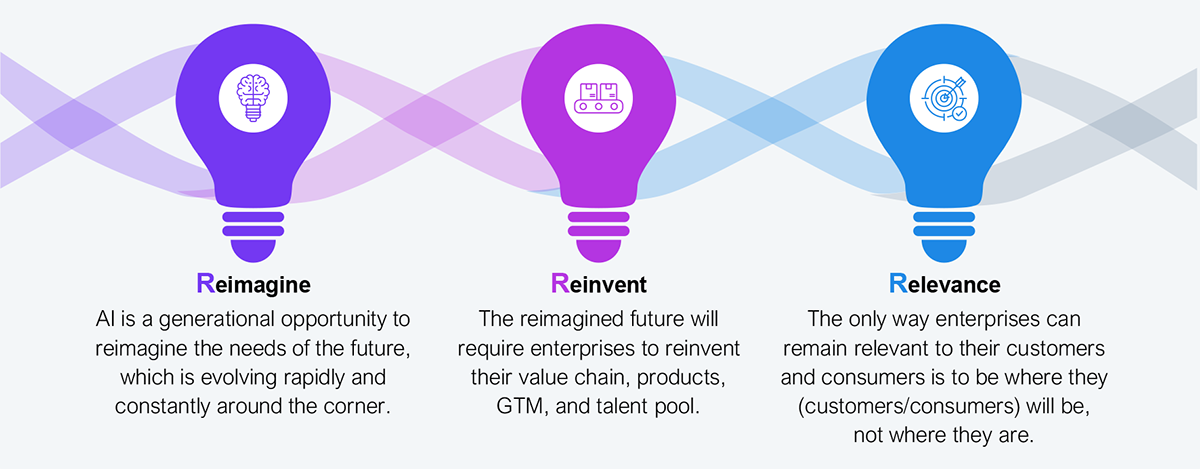Most enterprise AI efforts are stalling in POC purgatory, often focused on incremental productivity gains despite claims of driving innovation and growth. Recognizing this trend, 17 enterprise leaders (see Exhibit 1) across banking and financial services, consumer goods, manufacturing, and healthcare met in New York City to discuss ways to break this impasse. The HFS Research event, sponsored by LTIMindtree, dug into reimagining with AI, outlining a roadmap to enterprise AI adoption and the role of change management in maximizing its impacts.

Source: HFS Research, 2025
The discussion underscored the need to shift from traditional productivity metrics (speed to delivery, delivery cost, accuracy of delivery, and cost savings) to more meaningful business outcomes such as revenue growth and competitive advantage. Participants explored innovative use cases for AI that could fundamentally change business models and enhance customer experiences rather than just improve existing processes.
To exemplify how AI supports enterprise topline priorities, a healthcare leader shared that an AI-enabled predictive model for malnutrition increased hospital billing by capturing billable conditions that were typically not documented. Another example involved a financial institution using AI to personalize lending offers based on customer interactions, driving revenue growth rather than just improving operational efficiency.
Enterprises must anchor their AI strategy through a framework (see Exhibit 2) to enable consistent returns instead of a scatter-shot approach that supports a variety of POCs and pilots that don’t scale or yield the potential of AI. Without this, it is likely that the “death by a thousand POCs” cliché will come true.

Source: HFS Research, 2025
Several challenges are associated with adopting AI within organizations, including a lack of understanding of its true impact, sub-optimal use cases, and ineffective deployment. Enterprise leaders emphasized the importance of effective change management, addressing cultural resistance and ensuring that employees are brought along while transitioning to an AI-enabled business. The need for leadership support and integrating change management practices early in AI initiatives is critical to the success of AI adoption and impactful outcomes.
AI adoption won’t succeed without senior sponsors who understand the value of change management. Enterprise leaders across industries indicated that organizations often underfund change management efforts, leading to employee resistance. The need for a structured approach to bring employees along in the transition was emphasized, particularly in the healthcare and insurance industries where there is fear of job displacement.
A recurring theme was the necessity of having high-quality, well-structured data for successful AI implementation. The key challenges to ensuring the right data quality include data residing in silos across departments, data contextualization, and the need for a common understanding of what constitutes ‘AI-ready’ data. The complexities of data governance and the role of data officers in ensuring data integrity remain challenging. It is approaching crisis levels in highly regulated industries like healthcare and financial services. Enterprises are attempting to address the data challenge by hiring leaders (chief data officers), but real progress depends on empowering these leaders to make decisions with a budget to execute.
An enterprise leader said that their organization faced difficulties with data silos. By using a common data model and GenAI to map data to a standardized format, they significantly improved the accuracy of AI-driven insights. Another example involved the need for semantic ontologies to ensure data is appropriately contextualized, allowing for better decision-making and AI model training.
Productivity and cost management are essential to running efficient businesses that deliver high-quality outcomes for all stakeholders. However, those attributes have a ceiling with rapidly diminishing returns over time. AI’s value is best realized when used as a catalyst to rethink an enterprise’s value proposition and deliver against that.
Register now for immediate access of HFS' research, data and forward looking trends.
Get StartedIf you don't have an account, Register here |
Register now for immediate access of HFS' research, data and forward looking trends.
Get Started